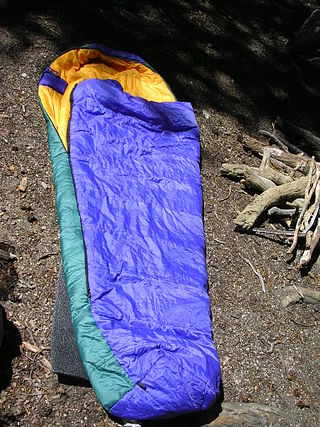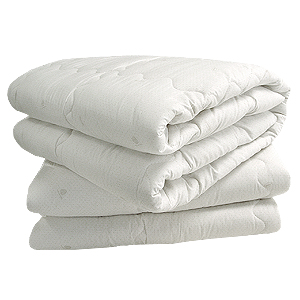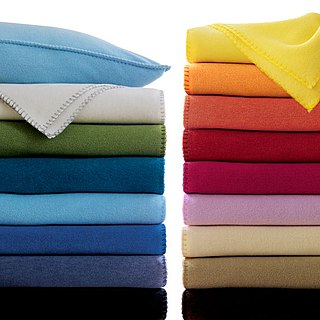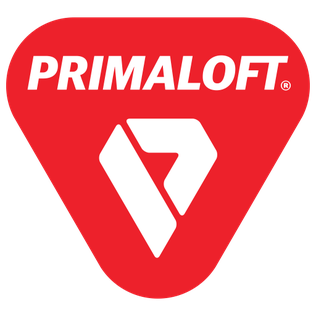Standard temperature and pressure (STP) are various standard sets of conditions for experimental measurements to be established to allow comparisons to be made between different sets of data. The most used standards are those of the International Union of Pure and Applied Chemistry (IUPAC) and the National Institute of Standards and Technology (NIST), although these are not universally accepted standards. Other organizations have established a variety of alternative definitions for their standard reference conditions.

Thermal insulation is the reduction of heat transfer between objects in thermal contact or in range of radiative influence. Thermal insulation can be achieved with specially engineered methods or processes, as well as with suitable object shapes and materials.

A sleeping bag is an insulated covering for a person, essentially a lightweight quilt that can be closed with a zipper or similar means to form a tube, which functions as lightweight, portable bedding in situations where a person is sleeping outdoors. It is also commonly used indoors for people who do not have beds or at sleepovers. Its primary purpose is to provide warmth and thermal insulation through its synthetic or down insulation. It also typically has a water-resistant or water-repellent cover that protects, to some extent, against wind chill and light precipitation, but a tent is usually used in addition to a sleeping bag, as it performs those functions better. The bottom surface also provides some cushioning, but a sleeping pad or camp cot is usually used in addition to that purpose. The bottom surface of a sleeping bag may be moderately water repellent, but a plastic tarp or groundsheet is often used to protect against moist ground.

In camping, a ground pad, sleeping pad, thermal pad, sleeping mat, or roll mat is lightweight pad, common among hikers, backpackers and budget travelers, often used in conjunction with a sleeping bag. Its purpose is to provide padding and thermal insulation. All types currently available use air as their primary form of insulation.

A duvet, usually called a comforter or (down-filled) quilt in American English, and a doona in Australian English, is a type of bedding consisting of a soft flat bag filled with either down, feathers, wool, cotton, silk, or a synthetic alternative, and is typically protected with a removable cover, analogous to a pillow and pillow case. The term duvet is mainly British, especially in reference to the bedding; rarely used in US English, it often refers to the cover. Sleepers often use a duvet without a top bed sheet, as the duvet cover can readily be removed and laundered as often as the bottom sheet.

Bedding, also called bedclothes or bed linen, is the materials laid above the mattress of a bed for hygiene, warmth, protection of the mattress, and decorative effect. Bedding is the removable and washable portion of a human sleeping environment. Multiple sets of bedding for each bed are often washed in rotation and/or changed seasonally to improve sleep comfort at varying room temperatures. Most standardized measurements for bedding are rectangular, but there are also some square-shaped sizes, which allows the user to put on bedding without having to consider its lengthwise orientation.
A silk comforter (絲綿被) is a bed covering, most often used as a duvet, and also commonly referred to as a silk duvet, silk quilt, or silk blanket. Originally used and made in China, since the late 20th century, silk comforters have become more common in Western market areas. Their increasing popularity stems from a combination of factors, including their thermal properties, their light weight, and their natural hypoallergenic properties. The opening of the Chinese market to the world since the 1990s has also played a significant role in the spread of silk comforters, as China is both the world's biggest silk producer and silk comforter manufacturer.

The down of birds is a layer of fine feathers found under the tougher exterior feathers. Very young birds are clad only in down. Powder down is a specialized type of down found only in a few groups of birds. Down is a fine thermal insulator and padding, used in goods such as jackets, bedding, pillows and sleeping bags. The discovery of feathers trapped in ancient amber suggests that some species of non-avian dinosaur likely possessed down-like feathers.

A comforter, also known as a doona in Australian English, or a continental quilt or duvet in British English, is a type of bedding made of two lengths of fabric or covering sewn together and filled with insulative materials for warmth, traditionally down or feathers, wool or cotton batting, silk, or polyester and other down alternative fibers. Like quilts, comforters are generally laid over a top bed sheet and used to cover the body during sleep. Duvets are another form of quilt, traditionally filled with feathers, though since the late 20th century often made of synthetic fibres or down alternatives.

Thinsulate is a brand of synthetic fiber thermal insulation used in clothing. The word is a portmanteau of the words thin and insulate, trademarked by 3M. The material is made by the 3M Corporation and was first sold in 1979. It was originally marketed as an inexpensive alternative to down; at the time, 3M claimed it was twice as warm as an equivalent amount of any natural material.

Polar fleece is a soft fabric made from polyester that is napped and insulating.
EN 13537 is a European standard designed to standardize the temperature ratings on sleeping bags manufactured and/or sold in Europe. As of 1 January 2005 a CEN criterion came into effect covering the testing and publication of temperature ratings for sleeping bags. The new criterion differs from the standards that existed formerly. In 2016 this standard was superseded by ISO EN 23537:2016.

Ultralight backpacking is a style of lightweight backpacking that emphasizes carrying the lightest and least amount of gear. While no technical standards exist, some hikers consider "ultralight" to mean an initial base weight of less than 4.5 kg (9.9 lb). Base weight is the weight of a fully loaded backpack at the start of a trip, excluding worn weight and consumables such as food, water, and fuel. Base weight can be lowered by reducing the weight of individual items of gear, or by choosing not to carry that gear. Ultralight backpacking is most popular among thru-hikers.

Hammock camping is a form of camping in which a camper sleeps in a suspended hammock rather than a conventional tent on the ground. Due to the absence of poles and the reduced amount of material used, hammocks can be lighter than a tent, though this is not always the case. Most hammocks will also require less space in a pack than a similar occupancy tent. In foul weather, a tarp is suspended above the hammock to keep the rain off of the camper. Mosquito netting, sometimes integrated into the camping hammock itself, is also used as climatic conditions warrant. Camping hammocks are used by campers who are looking for lighter weight, protection from ground-dwelling insects, or other ground complications such as sloped ground, rocky terrain and flooded terrain.
Hiking equipment is the equipment taken on outdoor walking trips. Hiking is usually divided into day-hikes and multiple-day hikes, called backpacking, trekking, and walking tours.
Layered clothing is the wearing of multiple garments on top of each other.

PrimaLoft® is a brand of patented synthetic microfiber thermal insulation material that was developed for the United States Army in the 1980s. PrimaLoft is a registered trademark of PrimaLoft, Inc., the brand's parent company.

A checkweigher is an automatic or manual machine for checking the weight of packaged commodities. It is normally found at the offgoing end of a production process and is used to ensure that the weight of a pack of the commodity is within specified limits. Any packs that are outside the tolerance are taken out of line automatically.

The down jacket, known more commonly in the fashion industry as a puffer jacket or simply puffer, is a quilted coat which is insulated with either duck or goose feathers. Air pockets created by the bulk of the feathers allow for the retention of warm air.

Insulating glass (IG) consists of two or more glass window panes separated by a space to reduce heat transfer across a part of the building envelope. A window with insulating glass is commonly known as double glazing or a double-paned window, triple glazing or a triple-paned window, or quadruple glazing or a quadruple-paned window, depending upon how many panes of glass are used in its construction.














